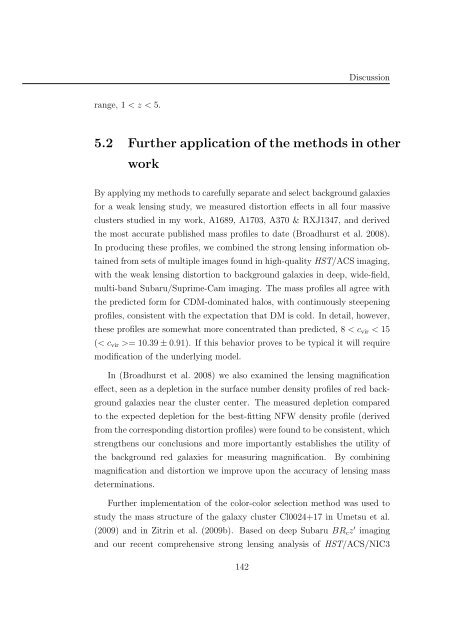Mass and Light distributions in Clusters of Galaxies - Henry A ...
Mass and Light distributions in Clusters of Galaxies - Henry A ...
Mass and Light distributions in Clusters of Galaxies - Henry A ...
Create successful ePaper yourself
Turn your PDF publications into a flip-book with our unique Google optimized e-Paper software.
Discussion<br />
range, 1 < z < 5.<br />
5.2 Further application <strong>of</strong> the methods <strong>in</strong> other<br />
work<br />
By apply<strong>in</strong>g my methods to carefully separate <strong>and</strong> select background galaxies<br />
for a weak lens<strong>in</strong>g study, we measured distortion effects <strong>in</strong> all four massive<br />
clusters studied <strong>in</strong> my work, A1689, A1703, A370 & RXJ1347, <strong>and</strong> derived<br />
the most accurate published mass pr<strong>of</strong>iles to date (Broadhurst et al. 2008).<br />
In produc<strong>in</strong>g these pr<strong>of</strong>iles, we comb<strong>in</strong>ed the strong lens<strong>in</strong>g <strong>in</strong>formation obta<strong>in</strong>ed<br />
from sets <strong>of</strong> multiple images found <strong>in</strong> high-quality HST/ACS imag<strong>in</strong>g,<br />
with the weak lens<strong>in</strong>g distortion to background galaxies <strong>in</strong> deep, wide-field,<br />
multi-b<strong>and</strong> Subaru/Suprime-Cam imag<strong>in</strong>g. The mass pr<strong>of</strong>iles all agree with<br />
the predicted form for CDM-dom<strong>in</strong>ated halos, with cont<strong>in</strong>uously steepen<strong>in</strong>g<br />
pr<strong>of</strong>iles, consistent with the expectation that DM is cold. In detail, however,<br />
these pr<strong>of</strong>iles are somewhat more concentrated than predicted, 8 < c vir < 15<br />
(< c vir >= 10.39 ± 0.91). If this behavior proves to be typical it will require<br />
modification <strong>of</strong> the underly<strong>in</strong>g model.<br />
In (Broadhurst et al. 2008) we also exam<strong>in</strong>ed the lens<strong>in</strong>g magnification<br />
effect, seen as a depletion <strong>in</strong> the surface number density pr<strong>of</strong>iles <strong>of</strong> red background<br />
galaxies near the cluster center. The measured depletion compared<br />
to the expected depletion for the best-fitt<strong>in</strong>g NFW density pr<strong>of</strong>ile (derived<br />
from the correspond<strong>in</strong>g distortion pr<strong>of</strong>iles) were found to be consistent, which<br />
strengthens our conclusions <strong>and</strong> more importantly establishes the utility <strong>of</strong><br />
the background red galaxies for measur<strong>in</strong>g magnification. By comb<strong>in</strong><strong>in</strong>g<br />
magnification <strong>and</strong> distortion we improve upon the accuracy <strong>of</strong> lens<strong>in</strong>g mass<br />
determ<strong>in</strong>ations.<br />
Further implementation <strong>of</strong> the color-color selection method was used to<br />
study the mass structure <strong>of</strong> the galaxy cluster Cl0024+17 <strong>in</strong> Umetsu et al.<br />
(2009) <strong>and</strong> <strong>in</strong> Zitr<strong>in</strong> et al. (2009b). Based on deep Subaru BR c z ′ imag<strong>in</strong>g<br />
<strong>and</strong> our recent comprehensive strong lens<strong>in</strong>g analysis <strong>of</strong> HST/ACS/NIC3<br />
142
















